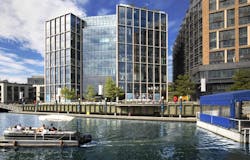How Hubbell’s Color-Tuning Technology Transformed a D.C. Law Office
When the Michael Best law firm decided to consolidate its three Washington D.C. office spaces into one brand new space, LED lighting controls were at the top of the company’s design wish list.
“It was very important to us to have a lighting system that was energy-efficient and very controllable,” says Kevin Barner, managing partner of the D.C. office for Michael Best. “We had worked with this technology before with Hubbell, since they’re one of our clients. We were definitely interested in their technology because we knew the details of it.”
Barner says he looked at around 40 different buildings (about 12 of them in person) for the law firm’s new space. The firm ultimately chose the new District Wharf development in D.C. for its location—still close to Capitol Hill and a beautiful view of the water—and its retail and restaurant offerings.
Color-Tuning Technology
Now located at the new District Wharf development, the Michael Best law firm is outfitted with SpectraSync™ Color Tuning Technology. Occupants can adjust and control both color temperature and intensity of certain fixtures.
Switch stations are equipped with four presets for proper light color and intensity, from cool to warm.
- Focus—5000K
- Work—4200K
- Normal—3500K
- Calm—2700K
Other switch stations can adjust brightness and turn lights on or off in certain rooms or zones. All features are meant to allow occupants to control their lighting based on mood, work requirements and daylighting conditions. The color temperature controls are meant to simulate changes in outdoor sunlight levels.
“Our new office space has varying degrees of natural light,” Barner explains. “There’s one wall up against another building, while another wall gets direct sunlight, so we have different amounts of ambient light in the space. It was important for us to create a space that had consistent lighting and good lighting—from a color temperature and brightness standpoint—throughout.”
For example, a meeting space can be set to cool lighting during business hours and warm lighting during a social event. Employees can also adjust luminaires in their personal offices and workspaces to meet their preferences and to enhance the colors or visibility of their work materials in the space.
[Related: How to Bring Children’s Library Design Into the 21st Century]
“We spend so much time in this space and having good lighting does affect people’s moods,” Barner says, adding: “We wanted to make sure we created a pleasant atmosphere for everybody to spend their day here and get a lot of work done.”
Using the Controls
With any new, cutting-edge technology, facilities managers and building owners should consider occupants’ reaction to the change. Barner says Michael Best employees run the gamut when it comes to their amount of lighting control use, but there’s a consensus that the technology is a welcome change. Educating occupants on how to use the controls was key.
“Most people are used to a standard dimming switch,” Barner says. But after guiding staff on how to properly use the controls and showcasing their benefits, an appreciation for the controllability and various options of the technology set in.
“I was surprised to see how many folks changed their attitude and mindset. They really do appreciate the ability to control the lighting in their environment,” he says.
Worth the Investment
Since the law firm moved into the District Wharf space in February 2019, Barner says the feedback on the new lighting system has been overwhelmingly positive. After spending time in the space, he says visitors comment on its noticeable differences. They even use the lighting to attract potential new hires.
Sophisticated sensors also allow the law firm to automatically adjust brightness levels, based on the amount of incoming natural light. And vacancy sensors have the power to override control of all fixtures to increase efficiency.
“The feedback has been excellent,” Barner concludes. “No one thinks it’s too complicated, and management has said it was worth the money.”
Read next: How Temple University’s New Library Uses Technology and Saves Space

